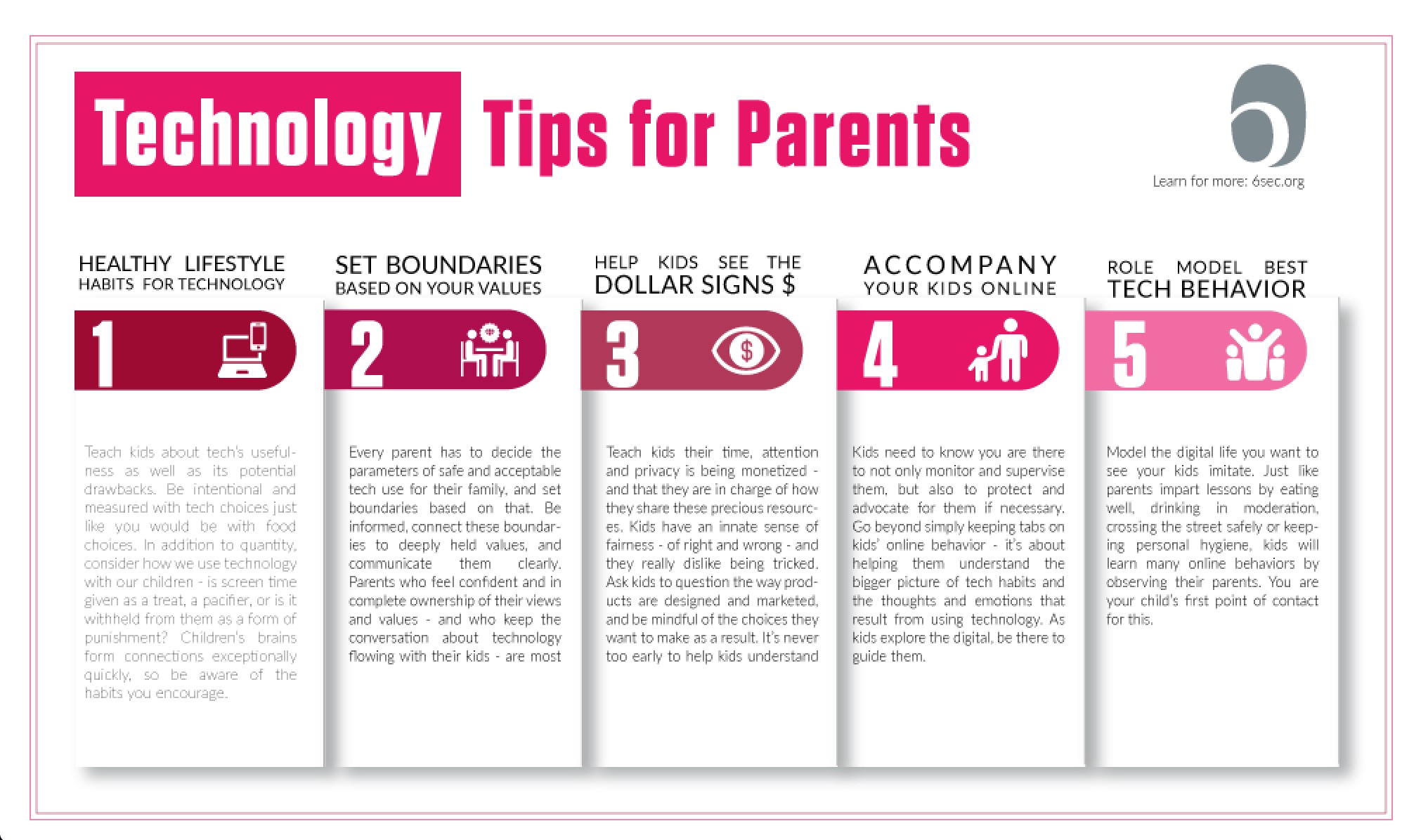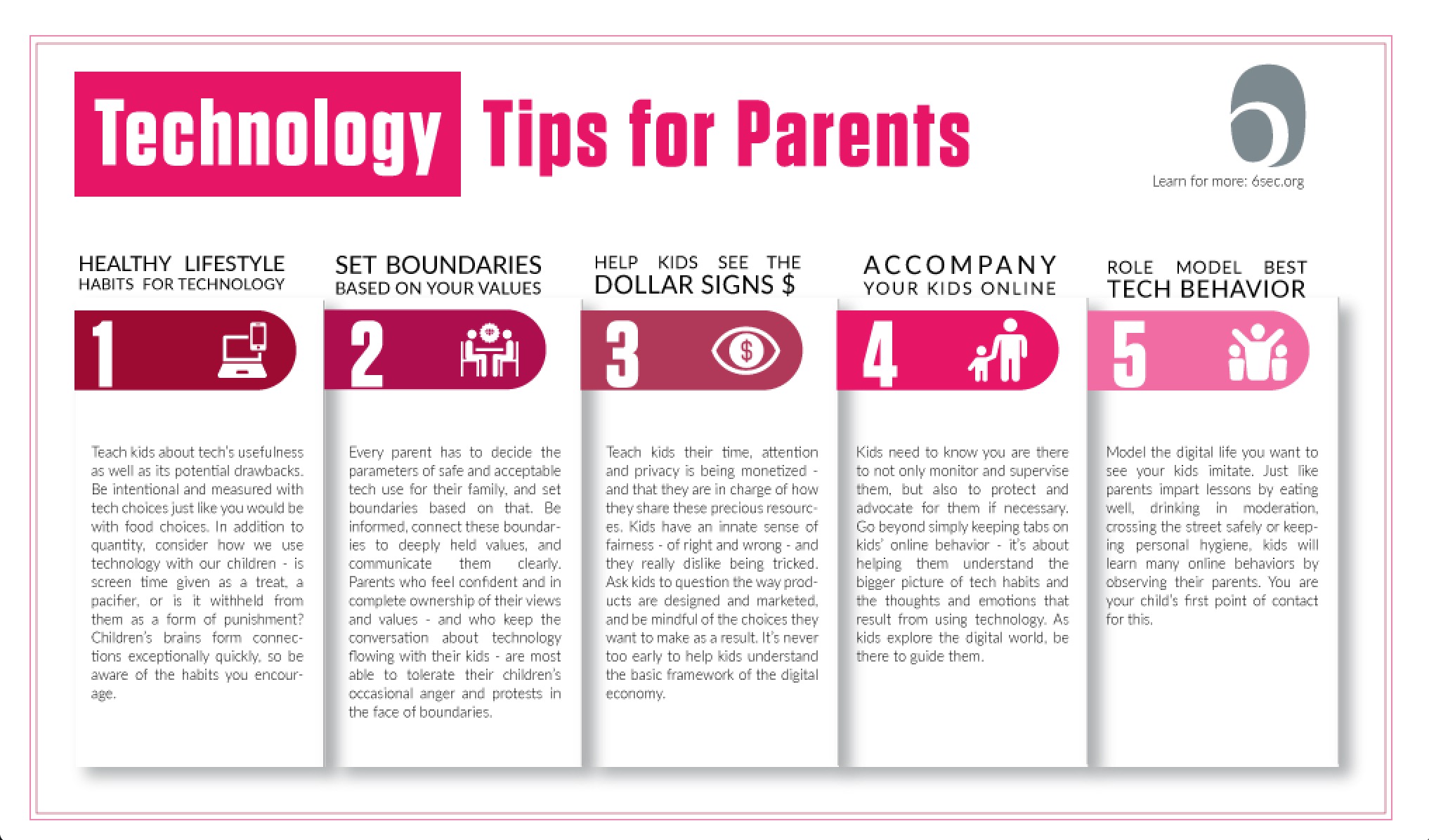Kids Navigating
the Digital World:
5 practical tips for parents
to equip kids with the skills
they need
As technology becomes increasingly enmeshed in every aspect of our lives, how can parents help kids develop healthy habits that will serve them as teenagers and into adulthood?
By Michael Miller
Azra came home from her first day of 6th grade, crying: “I’m the only one who doesn’t have a smartphone,” she told her dad, Murat Muhurdaroglu.
“Well, it’s good to be unique,” Murat thought. “But she was really upset, and it’s already such a tender age in terms of fitting in, so I agreed to look into it.”
He called around to the other parents, and to his surprise, found out that most of his daughters’ classmates did indeed have smartphones. In fact, the class had its own WhatsApp groups, which Azra couldn’t access without a smartphone. So next, Murat sat down with his wife. They had decided not to give their daughters smartphones until they turned 15, which was still several years away for Azra: “We were concerned about mental and physical health issues that are associated with technology overuse among youth. We wanted her to read and play instead of using a smartphone.” But at Azra’s urging, they reconsidered. “She was truly out of the communication loop. My wife and I discussed it that night and we were on the same page. There were pros and cons to having a phone or not. At that point we both thought that not having a phone would damage her in a different way. It was a short discussion. We decided to buy an iPhone next day.”
A week later, Azra came home crying again. This time, it wasn’t because of what she couldn’t do without a smartphone, but because of what she could do with one. She had gotten into an argument on WhatsApp with a boy in her class, and he had threatened to report her to the school headmaster. For Murat, a Six Seconds Preferred Partner based in Istanbul, this served as a wakeup call: “That’s when I realized that I had given her the phone but not the knowledge, skills, and attitudes she needs to navigate the digital world.”
According to the data, his daughter isn’t alone by any means in her lack of preparedness to deal with these powerful new technologies.
Screen time correlated with mental health issues
A robust and growing body of research indicates that excessive technology use is a widespread problem – with dire consequences for teens’ mental health: Social media use, in particular, has been linked to increased anxiety, depression and social isolation. According to a study of young adults published in The American Journal of Preventive Medicine, those in the top 25% of social media use were more than 3x as likely to report feeling socially isolated. Consider the irony: instant connection on social media correlated with social isolation. And in another study, researchers have found that the severity of adolescents’ anxiety and depression symptoms rose in accordance with increased screen time.
Interestingly, teenagers aren’t naïvely unaware of what’s happening. They are actually quite self-aware that their technology use is problematic.
Teens recognize the problem – but feel ill equipped to change
According to teenagers themselves, tech use is a problem. In a study from the Pew Research Center, 90% of teens called the amount of time their age group spends online a “problem.” And 60% of those surveyed called it a “major problem.” More than half – 54% – said they spend too much time on their cell phone, and 41% admitted to spending too much time on social media.
In spite of this, many feel unable to rein it in. And in their defense, the deck is stacked against them. Neurobiological and hormonal changes in the teenage brain intensify their desire to fit in, to be liked and respected. And social media apps have been specifically designed to activate the brain’s social reward centers – to be liked and shared. The methods tech companies have chosen to solidify users’ habits match up perfectly with teens’ vulnerabilities.
That’s why parents need to ensure they equip their kids with the skills and attitudes they need to navigate a tech-saturated world – as Murat wished he had done a better job of with Azra. For advice on how to do that, we turn to Teodora Pavkovic, a psychotherapist, parenting coach and expert on digital wellness for children and parents.
Here are 5 of her practical tips for parenting in the digital age:
Free Poster - Technology Tips for Parents
Download this free poster to refer back to as you navigate parenting in the 21st century.

5 Practical Tips for Parents to Prepare Kids for Tech Use
1. Create healthy habits around technology. “Tech-time is like food,” Pavkovic says, “and not all food is created equal. Kids can’t grow and develop to be healthy with a steady diet of just protein, or just sugar, and it’s the same with technology. It’s crucial to be intentional and measured.” It’s not just about the quantity, either. Pavkovic says it’s also important to consider how we use technology with our children when they are very young – is screen time given as a treat, a pacifier, or is it withheld from them as a form of punishment? Children’s brains form connections exceptionally quickly, and the rules we set in place for them early on become embedded and hard to alter. “Technology is a tool, after all, and we want to teach them about its usefulness as well as its potential drawbacks – and we want to do this at developmentally appropriate stages.”
2. Set boundaries based on your values. How much screen time and technology consumption should be allowed? Pavkovic says every parent or couple has to decide the parameters of safe and acceptable tech use for their family, and set boundaries based on that. “The important part is to be informed as a parent, and to make sure you communicate to your child why the rules are what they are. I have found, time and again, that parents who feel confident and in complete ownership of their views and values – and who keep the conversation about technology flowing with their kids – are most able to tolerate their children’s occasional anger and protests in the face of boundaries.” Pavkovic also notes the irony that it’s the parents who live and work in Silicon Valley that are by now notoriously known for imposing the strictest boundaries around technology consumption – perhaps because they understand technology from the inside-out and are more aware of its impact and potential risks.
3. Help kids see the dollar signs. Teaching kids that access to their time, attention and privacy is being monetized is one half of the most important technology use lesson – the other is that they are in charge of how they share these precious resources. “Kids have an innate sense of fairness – of right and wrong – and they really dislike being tricked. They are incredibly adept at picking up on this, especially during that Middle School phase!” Pavkovic recommends asking kids to question the way products are designed and marketed, and be mindful of the choices they want to make as a result. YouTube, for example, needs you to watch and consume its videos and spend as much time as possible on its platform, and so it recommends videos that its algorithms predict you may want to watch. Netflix operates in a similar way: its CEO Reed Hastings has said, “You get a show or a movie you’re really dying to watch, and you end up staying up late at night, so we actually compete with sleep.” We must never forget that there is a large number of apps and platforms in the digital universe, all desiring to be used and to have their content consumed by us. “It’s never too early to help kids understand the basic framework of the digital economy,” Pavkovic says.
4. Accompany your kids. Just as parents would never leave their child unaccompanied in an airport or a mall, surrounded by strangers, parents should also be a steady presence as their children take their first few eager steps into the online world. But it shouldn’t stop there. “They need to know someone is there to not only monitor and supervise them, but also to protect and advocate for them if necessary.” This has to go beyond simply keeping tabs on kids’ online behavior – it’s about helping kids understand the bigger picture of tech habits and the thoughts and emotions that result from using technology. As kids explore the digital, be there to guide them. “If you find them reluctant to initiate a conversation about their experiences (highly likely with the teens!), get the ball rolling yourself by talking about how, for example, using Instagram makes you feel. The endless scrolling of picture-perfect bodies, puppies and food impacts both your mood and thinking, and it’s so valuable to share that with your children who will likely be on the platform soon enough themselves.”
5. Model the best and most desired behaviors. Do it for the kids! Parents do this in so many different places already, whether it’s driving or crossing the street safely, eating right, drinking in moderation (or not at all), keeping personal hygiene, and even having the political or religious views that are in-line with your family’s values. How we consume technology and how big of a space we carve out for it within our lives is the latest set of best practices we need to impart on our children. “Parents have a huge responsibility to model the kind of digital citizenship they want to see their children imitate one day – it takes a village, as the old saying goes, and it’s schools, tech companies and religious communities that all need to come together and contribute, but you are your child’s first point of contact for this.”
 Teodora Pavkovic is a Psychologist, International Speaker and Parenting Coach based in New York. Visit her website, follow her on Facebook or Twitter, or watch her fabulous TEDx talk. Also, save your spot at the EmotionsAI Virtual Conference and tune in for the 22nd Century Learning panel featuring Teodora alongside an amazing group of panelists.
Teodora Pavkovic is a Psychologist, International Speaker and Parenting Coach based in New York. Visit her website, follow her on Facebook or Twitter, or watch her fabulous TEDx talk. Also, save your spot at the EmotionsAI Virtual Conference and tune in for the 22nd Century Learning panel featuring Teodora alongside an amazing group of panelists.
 Murat Muhurdaroglu is a Managing Partner at Arma Consultancy and Learning Solutions, based in Istanbul, Turkey. He is a Six Seconds Preferred Partner and a representative of the DQ Institute in Turkey, an international think-tank dedicated to digital intelligence education. You can find Murat on LinkedIn.
Murat Muhurdaroglu is a Managing Partner at Arma Consultancy and Learning Solutions, based in Istanbul, Turkey. He is a Six Seconds Preferred Partner and a representative of the DQ Institute in Turkey, an international think-tank dedicated to digital intelligence education. You can find Murat on LinkedIn.
What’s new in emotional intelligence?
Emotional Intelligence at Work: The Free, Easy Win Most Managers Are Missing
Gallup study compares the biggest gaps in employee vs. manager perceptions. What are managers’ worst blind spots? What are easy wins they could do better to improve team performance?
Is Boredom Bad for Kids? Emotional Intelligence Education News
Let’s unpack boredom and how emotional intelligence can help you with tips to support bored children (and keep your cool!). Keep reading for EQ research and resources you can use for you, your faculty and students.
Effective Emotional Intelligence Coaching: 4 Questions to Improve Client Outcomes with Social and Cultural Insights on Emotions
Improve your emotional intelligence coaching by understanding the social and cultural influences on emotions. Ask these 4 key questions for more effective client relationships
Krish and Anabel: SEL Pioneer and Mentee Share 6 Life Lessons on Empathy, Integrity, and Emotional Intelligence
What are 6 life lessons you’ve learned? Dr. Anabel Jensen, SEL pioneer and Six Seconds President, explores this important question with her 16-year-old mentee.
Voices from the Network: Jeremy Jensen
In this Voices from the Network, we sit down with Police Chief Jeremy Jensen, who is doing emotional intelligence training with his officers in Dubuque, Iowa.
Emotional Intelligence at Work: Is There Hope for Toxic Workplaces?
The remarkable transformation at Westcomm Pump offers a blueprint for turning around workplaces with depleted morale and trust issues, using the Team Vital Signs assessment.
- Pursue Noble Goals in the Six Seconds Model of EQ - July 29, 2023
- Increase Empathy in the Six Seconds Model of EQ - July 26, 2023
- Exercise Optimism - July 24, 2023








This is great! So logical & to-the-point!